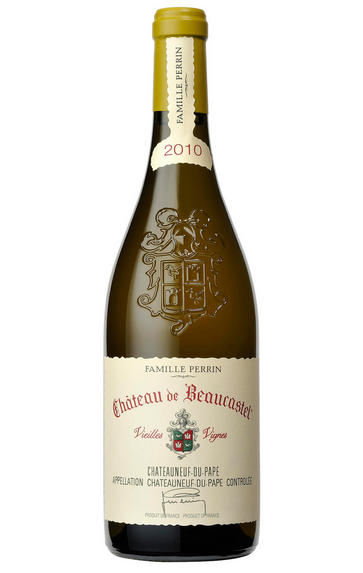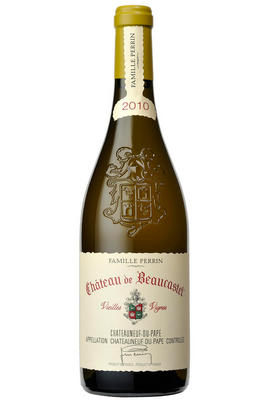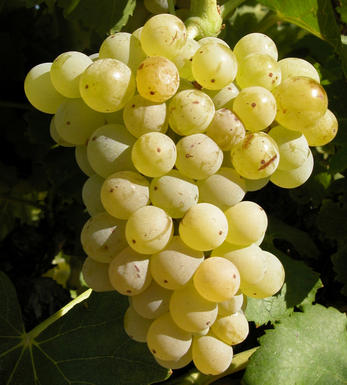
2011 Châteauneuf-du-Pape, Roussanne, Vieilles Vignes, Château de Beaucastel, Rhône

Critics reviews
Robert M. Parker, Jr. - 31/10/2012
Jancis Robinson MW, jancisrobinson.com – 26 Feb 2013
As I said last year, the Perrin family is a large one indeed, with brothers Jean-Pierre and Francois sitting at the top of the hierarchy and their four sons, Mathieu, Pierre, Thomas and Marc increasingly taking charge of their negociant business and their extensive estates throughout Southern Rhone. Now controlling over 1200 acres, as well as having a network of contracts, this operation is the equivalent of a major Southern Rhone train operating at high speed. Moreover, they are doing some incredible work in all price ranges. Other 2011s that the Perrin boys have produced include the following wines, which were very good across the board, especially for 2011s. In particular, readers need to take a hard look at their estate in Vinsobres, which is making the finest wines of that appellation, and more recently, what they are doing in Gigondas with the estate they purchased there, Clos des Tourelles. These are special wines. There are now three cuvees of Gigondas from the Perrins - the Gigondas La Gille, the Gigondas Vieilles Vignes and the Gigondas Clos des Tourelles. All three merit serious attention. Tasting the 2010s, which were all set to go into bottle right after my visit, certainly shows that this vintage is impressive, although I'm not sure that Marc and Pierre Perrin haven't done as good a job with their selections in 2011. Three cuvees of Gigondas look to all have outstanding potential and will probably be in bottle by the time this report is published.
Robert Parker, Wine Advocate #204, Dec 2012
About this WINE

Chateau de Beaucastel
The Perrin family of Châteauneuf-du-Pape are one of the Rhône Valley’s greatest vineyard owners. With over 200 hectares of top level, prime vineyards at their fingertips, they have the terroir and skill required to produce some of the region’s finest wines.
The estate traces its history back to a plot of Coudoulet vines bought by Pierre de Beaucastel in 1549. The estate was transferred into the Perrin family in 1909 through marriage, where it remains firmly to this day. Despite being one of the old guards of the region, they are also one of the most progressive estates. They were one of the first converts to organic and biodynamic faming in Châteauneuf-du-Pape, which they adopted in 1950 and 1974 respectively.
César Perrin, winemaker at Beaucastel, is very happy with his 2021s. He tells of a cool and long growing season producing wines which are bright, fresh and lower in alcohol than has become the norm in recent years. Their Syrah vines were more heavily impacted by the Spring frosts, so a higher percentage of Mourvèdre - already signature of the Perrin’s style - went into the Beaucastel red than usual (40%, whereas the norm is nearer 30%). This helps bolster the dark fruit profile of the wine, as well as ensuring a balanced tannin structure.
We offered the Perrin’s full range of wines upon release in October last year, though we held back a small amount of their two flagship Château de Beaucastel wines so we could offer them to anyone who missed out.

Châteauneuf-du-Pape
The most celebrated village of the Southern Rhône, Châteauneuf-du-Pape is the birthplace of the now indispensable French Appellation d’Origine Contrôlée system – imperfect though it may be. Compared to the Northern Rhône, the vineyards here are relatively flat and often feature the iconic galet pebbles – the precise benefits of which are a source of much debate. Minimum alcohol levels required by the AOC are the highest in France, but at 12.5% it is well below the natural generosity of Grenache, which only achieves its full aromatic potential when it is fully ripe and laden with the resultant high sugars. Syrah and Mourvèdre contribute the other defining elements in the blend, adding pepper, savoury spice and structure to the decadent Grenache. There are a further 10 permitted red grape varieties which can be used to adjust the “seasoning”. Of the five white varieties permitted, it is Grenache Noir’s sibling – predictably perhaps – Grenache Blanc, which dominates, though Roussanne shows a great deal of promise when handled well, notably at Château de Beaucastel.

White Rhône Blend
With the exception of the wines from Condrieu and Château-Grillet virtually all Rhône Valley whites are made from blends.
In the north, the white wines of Hermitage, Crozes-Hermitage, St-Joseph, and St-Péray are produced from blends of Marsanne and Roussanne. Generally Marsanne is the dominant partner and it lends colour, body and weight to the blend, as well as richly scented fruit. Roussanne, a notoriously low yielder and pernickety to grow, produces intensely aromatic wines which contribute bouquet, delicacy and finesse to the blend.
Until about 15 years ago there was very little interest in southern Rhône whites as it was widely believed that the combination of dull non aromatic grapes and the baking summer heat meant quality wine production was nigh impossible. Since then the quality has improved markedly through the introduction of cool fermentation techniques and increased plantings of northern Rhône white grapes.
The base of many blends is still Grenache Blanc, a widely planted variety producing fresh wines with apple-like fruits, often with hints of aniseed. Ugni Blanc is still found in many blends, as is Clairette though their general lack of character and definition has led to a reduction in plantings. The future for southern Rhône whites appears to lie with Roussanne, Marsanne, and, increasingly, Viognier.


Buying options
Add to wishlist
Description
Arguably the best wine in the Southern Rhône, some say the whole of the Rhône Valley, this is an extraordinary achievement. Following 50% maturation in barrique and 50% in cuve, notes of Mandarin, quince, honeycomb and wax all vie for attention. The texture is creamy and a little toasty, yet it still has a spicy, salty iodine finish. All is in wonderful suspended tension, like a late Beethoven sonata played by Brendel.
Simon Field MW, BBR Buyer
Ch. de Beaucastel’s 200 hectare estate is farmed organically, its other calling cards being the rather controversial vinification à chaud at the start of fermentation and the less contentious use of all 13 of the permitted grape varieties, albeit in somewhat differing volumes. Marc Perrin compares the 2011 with 2000; both were quick off the blocks and finished with an Indian flourish; both were somewhat lacklustre mid-season, which delayed or at least slowed down the growing cycle. Both, he concludes, have produced significantly above average wines. We see no reason to disagree with him.
wine at a glance
Delivery and quality guarantee